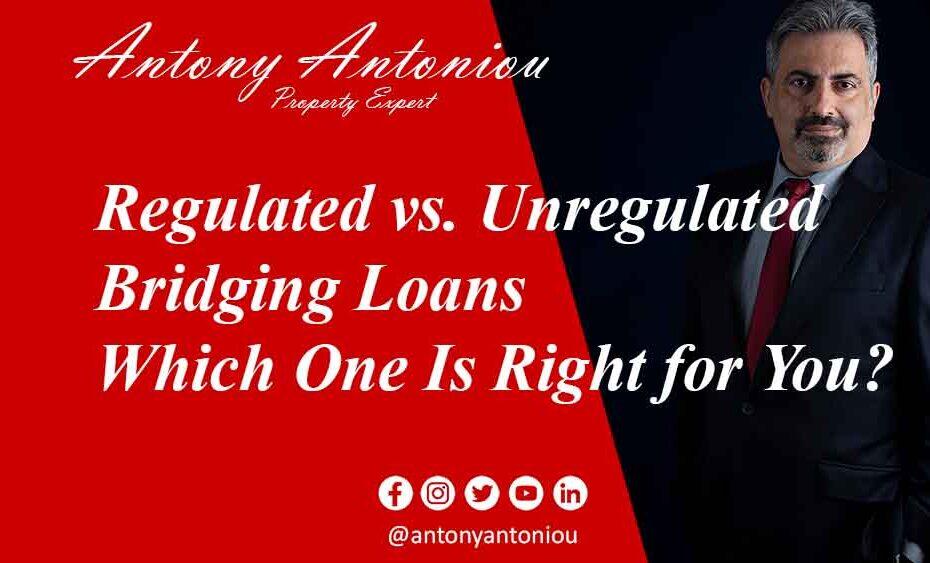Regulated vs. Unregulated Bridging Loans – Which One Is Right for You?
When it comes to obtaining the right financing for your property needs, bridging loans offer a flexible and efficient solution. Whether you’re purchasing a new property, refurbishing an existing one, or need quick funds for a property chain break, bridging finance can be a game-changer. However, it’s essential to understand the key differences between regulated and unregulated bridging loans to make an informed decision.
Regulated Bridging Loans: A Closer Look
Regulated bridging loans fall under the purview of the Financial Conduct Authority (FCA), meaning they are subject to certain rules and regulations. These loans come into the ‘regulated’ category when they are secured against a property that is currently occupied. To qualify, the borrower must have an intention to reside in the property while the loan is in place.
Typically used for residential purposes, regulated bridging loans have a maximum loan term of 12 months. The FCA’s oversight ensures that consumers are protected against incorrect advice or mis-selling, providing some peace of mind during the borrowing process.
It’s essential to debunk a common myth regarding regulated loans – they do not necessarily come with lower interest rates. The FCA does not impose any restrictions on the interest rates or fees charged by lenders. So, while regulatory protection is an advantage, borrowers should carefully compare the rates and terms offered by different lenders.
When considering a regulated residential bridging loan, it’s important to understand that you either need to secure a mortgage for the exact balance or have a solid plan to sell the property within the specified period.
What Can You Use a Regulated Bridging Loan For?
Regulated bridging loans are versatile and can be used for various purposes, including:
1. Purchasing a property at auction: When you need quick funds to secure a property at an auction, a regulated bridging loan can come to the rescue.
2. Property chain break: If you find yourself in a property chain break situation and need immediate financing to keep things moving, a regulated bridging loan can help bridge the gap.
3. Purchasing a property to reside in: If you intend to buy a property as your primary residence, a regulated bridging loan can provide the necessary funds while you sort out other financing options.
How Much Can You Borrow with a Regulated Bridging Loan?
The amount you can borrow with a regulated bridging loan depends on several factors, including the value of your property and your personal financial circumstances. Lenders will assess the property’s market value and your ability to repay the loan within the specified term.
Unregulated Bridging Loans: What You Need to Know
Unregulated bridging loans, as the name suggests, are not regulated by the Financial Conduct Authority (FCA). These loans are typically used for business or investment purposes, where the secured property will not be occupied by the borrower or their family.
This category of bridging loans is more popular among property investors and developers who need quick funds to capitalize on investment opportunities or facilitate property development projects.
What Can You Use an Unregulated Bridging Loan For?
Unregulated bridging loans are ideal for various business-related purposes, such as:
1. Purchasing a buy-to-let property: When you want to invest in rental properties, an unregulated bridging loan can be the perfect solution to seize lucrative opportunities.
2. Refurbishing a property: If you aim to renovate a property and increase its value, an unregulated bridging loan can provide the necessary financial boost.
3. Property flipping: Property developers often utilize unregulated bridging loans to quickly purchase and renovate properties for a profitable resale.
4. New business venture: If you’re embarking on a new business venture and need short-term financing, an unregulated bridging loan can help get your enterprise off the ground.
How Much Can You Borrow with an Unregulated Bridging Loan?
The amount you can borrow with an unregulated bridging loan depends on factors such as the property’s value and your financial standing. Lenders will assess your ability to repay the loan and the potential profitability of your business venture or investment.
Choose Wisely: Regulated or Unregulated Bridging Loan?
– Bridging loans offer flexible financing options for property needs.
– Regulated bridging loans are subject to rules and regulations by the Financial Conduct Authority (FCA).
– Regulated loans are secured against properties occupied by the borrower for residential purposes.
– Unregulated bridging loans are not FCA-regulated and are used primarily for business or investment purposes.
– Regulated loans do not necessarily come with lower interest rates; rates vary among lenders.
– Regulated loans are suitable for residential property purchases, property chain breaks, and primary residence acquisitions.
– Unregulated loans are used for buy-to-let properties, property refurbishment, flipping, and new business ventures.
– The loan amount for both regulated and unregulated loans depends on property value and individual financial circumstances.
– Choose between regulated and unregulated bridging loans based on your specific needs and goals.
Selecting the right type of bridging loan largely depends on your specific needs and financial goals. If you plan to reside in the property and need additional regulatory protection, a regulated bridging loan may be the way to go. On the other hand, if you’re a property investor or developer seeking quick funds for business purposes, an unregulated bridging loan could be a better fit.

